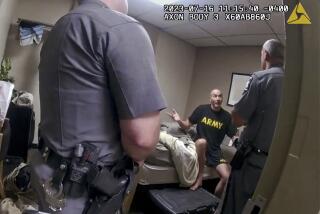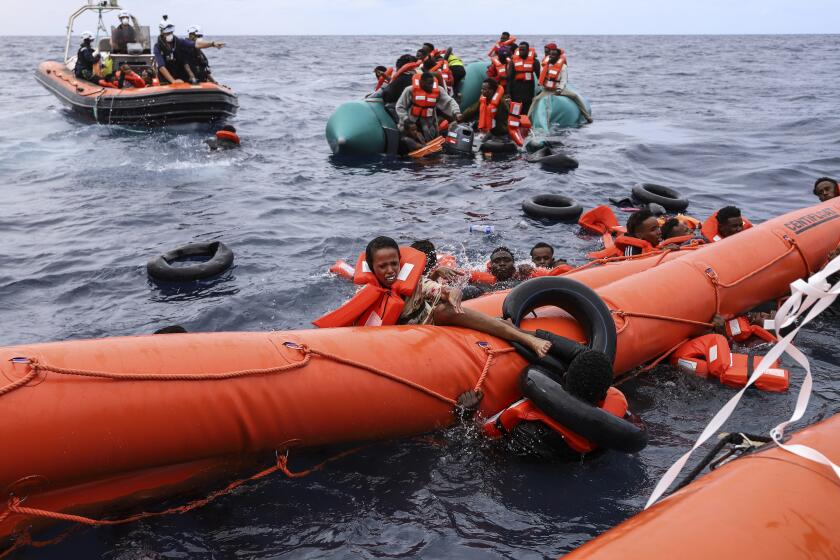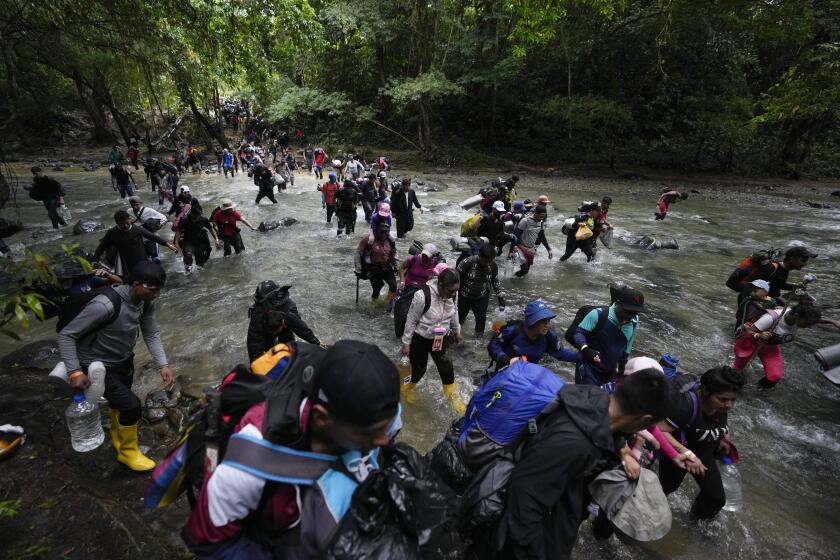INS Chief to Push Tougher Policy on Alien Smuggling
The new head of the federal Immigration and Naturalization Service, in a significant shift in enforcement strategies along the U.S.-Mexico border, said Thursday that his agency will seek to formally deport or jail smugglers of illegal aliens and those unauthorized immigrants who repeatedly slip into the United States.
The planned policy shift, outlined by INS Commissioner Gene McNary at a press conference here, represents a toughening of the INS’s customary practice of allowing most unauthorized immigrants to return voluntarily to their homeland soon after capture. Officials have long targeted smugglers, but McNary said prosecutions would be expanded considerably.
The new get-tough approach was immediately condemned by critics as unworkable, simplistic and impractical--particularly in light of the service’s shortage of detention space and personnel, shortcomings that some say leave the agency impotent to control the huge volume of people who enter the United States without inspection each day.
At a Los Angeles news conference announcing the new approach, commissioner McNary was vague about the details of how it will work. He said the program should act as a deterrent against illegal immigration. He did not elaborate on when it would begin or or how it might affect an already overworked INS bureaucracy. But the commissioner, who has been on the job for seven months, said the step is a necessary one to “regain control of the border,” and he explained later that he would like to see the new policy in place soon.
“Those people who are apprehended will be detained,” said McNary, the former Missouri county executive whose comments Thursday were the most extensive
he has made to date on the border issues that are high on his agenda.
Under the new policy, the commissioner said, repeat offenders and alien smugglers will be identified and fingerprinted, something the agency does now only in limited cases. He said repeated offenses will mean jail terms, as opposed to temporary detention by the INS.
Under current procedures, nearly all captured aliens, most of whom are Mexicans, declare their wish to return home, sign release forms and, in most instances, are quickly sent back, usually within three to eight hours. Immigration experts, including many INS officials, believe the practice--which is largely a function of the lack of detention space and shortages of enforcement and court personnel--encourages aliens to repeatedly try to jump the border.
“You can’t just continue letting them out the back door and think you are enforcing the law,” McNary said in an interview after the news briefing.
Particularly targeted under the get-tough stance, McNary said, would be the San Diego area, where about 40% of all illegal immigration via the U.S.-Mexico border is believed to take place.
The Tijuana-San Diego corridor provides the most direct access to the booming immigrant job markets of Southern California, a region that researchers and officials say is drawing more and more immigrants--legal and illegal.
Officials have estimated that about one of every three aliens attempting a crossing is captured. Last year, agents recorded nearly one million arrests of illegal immigrants in the United States; 90% were Mexican citizens, most of whom were quickly dispatched back home.
It was unclear precisely how immigration authorities plan to implement McNary’s new strategy. The policy shift seemingly will require a vast increase in immigration detention space, but current expansion plans would appear to be far short of what is needed.
“There’s an obvious limitation locally in that we don’t have any place to put them,” said Ted Swofford, a spokesman in San Diego for the U.S. Border Patrol, the INS enforcement arm. The patrol has only 260 detention beds in San Diego, Swofford said, and those are “always full.”
In fact, the INS now only has about 900 beds available in the entire Western region, which includes all of California, Arizona, Nevada, Hawaii and Guam. Current expansion plans would bring that number up to 1,400 in the next year or so.
In the San Diego area alone, however, Border Patrol agents are recording an average of 1,400 arrests a day during 1990. Most of those detained sign forms and agree to return to Mexico, usually to attempt to enter anew through the rugged border terrain.
Several immigrant-rights advocates contacted assailed McNary’s proposed shift in policy, contending that it will be unworkable because of limited detention capacity and the inability of the federal court system to handle the caseload that would develop. Moreover, critics pointed out that it is often difficult to identify and make cases against smugglers and chronic border-jumpers, particularly since aliens routinely give false names. Authorities only take fingerprints of about 5% of unauthorized immigrants arrested in San Diego.
“(This) could have major implications in terms of enforcement, overcrowding of detention facilities, the backlog in the judicial system,” said Charles Wheeler, director of the National Immigration Law Center, a rights group in Los Angeles. “It’s incredibly misguided to think that this will discourage the majority of people who now come to the United States.”
Arnoldo Torres, national political adviser for the League of Latin American Citizens, wondered whether McNary had contemplated the consequences of his plan.
“Has he thought about violations of rights in these detention centers?” Torres asked. “Has he thought about the major problems in the communities where these facilities will be built?”
In fact, rights activists have long criticized conditions in INS holding facilities. And opposition from U.S. citizens and others has contributed in the last two years to the INS decision to back out of two planned new detention centers, one in Oakland and one in eastern San Diego County.
McNary, during and after the press conference, hinted that plans for greatly expanded detention space are in the works for the San Diego area. But, although stressing the need for such facilities, he provided no details.
“Detention is the key to enforcing the law,” he said, contending that the threat of jail is the only way to deter undocumented border crossers.
That view is disputed by immigrant advocates, who say that augmenting detention capacity will do little to halt the movement of people driven to desperation by economic and political disruption.
During his Los Angeles news conference, McNary recalled how INS officials, strapped for detention space, housed 2,500 Central Americans last year in a makeshift tent city and other facilities in south Texas. However, he stopped short of endorsing the controversial tent-city approach for San Diego, and emphasized that the voluntary-return policy will remain in place for the many unauthorized immigrants who are not arrested for multiple illegal entries onto U.S. soil.
“We’re not going to be able to turn this around overnight,” he told reporters. “But we’ll try and identify (alien) smugglers . . . fingerprint them, detain them.”
As part of his overall toughened approach, McNary repeated an earlier vow to attempt to bolster the uniformed strength of the Border Patrol in the San Diego by 260 agents, to about 1,000 officers, within a year.
The extra personnel, he said, would be shifted from other duties elsewhere in the country and would be brought in from among new agents graduating from the Border Patrol academy in Georgia.
During the news conference, McNary also voiced the hope that the escalating numbers of robberies and assaults against migrants along the border in San Diego could be reduced through a variety of methods--jailing more people for long periods, installing lights in border zones, posting more border guards, and improving fences and other barriers. The large groups that now gather daily along the border contribute to crime and other disruption, McNary said.
“We know that the crowds in the staging areas in San Diego can be dispersed,” McNary said. “That’s not a border problem, that’s a humanity problem. . . . It is a situation that is intolerable.”
He expressed particular support for the notion of installing more lights, which he called “perhaps the best technique in eliminating the violence and the crowds of people.”
However, McNary attempted to distance himself publicly from the huge and controversial Light Up the Border movement. That San Diego-based group--criticized by some as a throwback to U.S. nativist movements of the past--has attempted to draw attention to illegal immigration by massing along the international boundary line and shining vehicle headlights southward.
“I think it will probably just run their batteries down,” McNary said of the group’s tactic.
But the commissioner acknowledged that the group had galvanized a widespread perception that the border is “out of control,” and, he added, “You don’t need 1,000 people putting on their headlights to tell you that.”
Later, as part of his first Los Angeles visit to inspect INS facilities, McNary told a Town Hall luncheon audience that he personally favors a combined point system and lottery to allow some foreigners with no “family or prospective employer” connections to lawfully immigrate to the United States.
“All of our skill-based immigration is now employer-driven,” he said in prepared remarks. “I’d like to see someone without that connection have a chance, too. A person who says, ‘I just want to work in America and raise my family there,’ would bring as many benefits to this country as someone with a much-desired occupational skill.”
More to Read
Start your day right
Sign up for Essential California for news, features and recommendations from the L.A. Times and beyond in your inbox six days a week.
You may occasionally receive promotional content from the Los Angeles Times.






